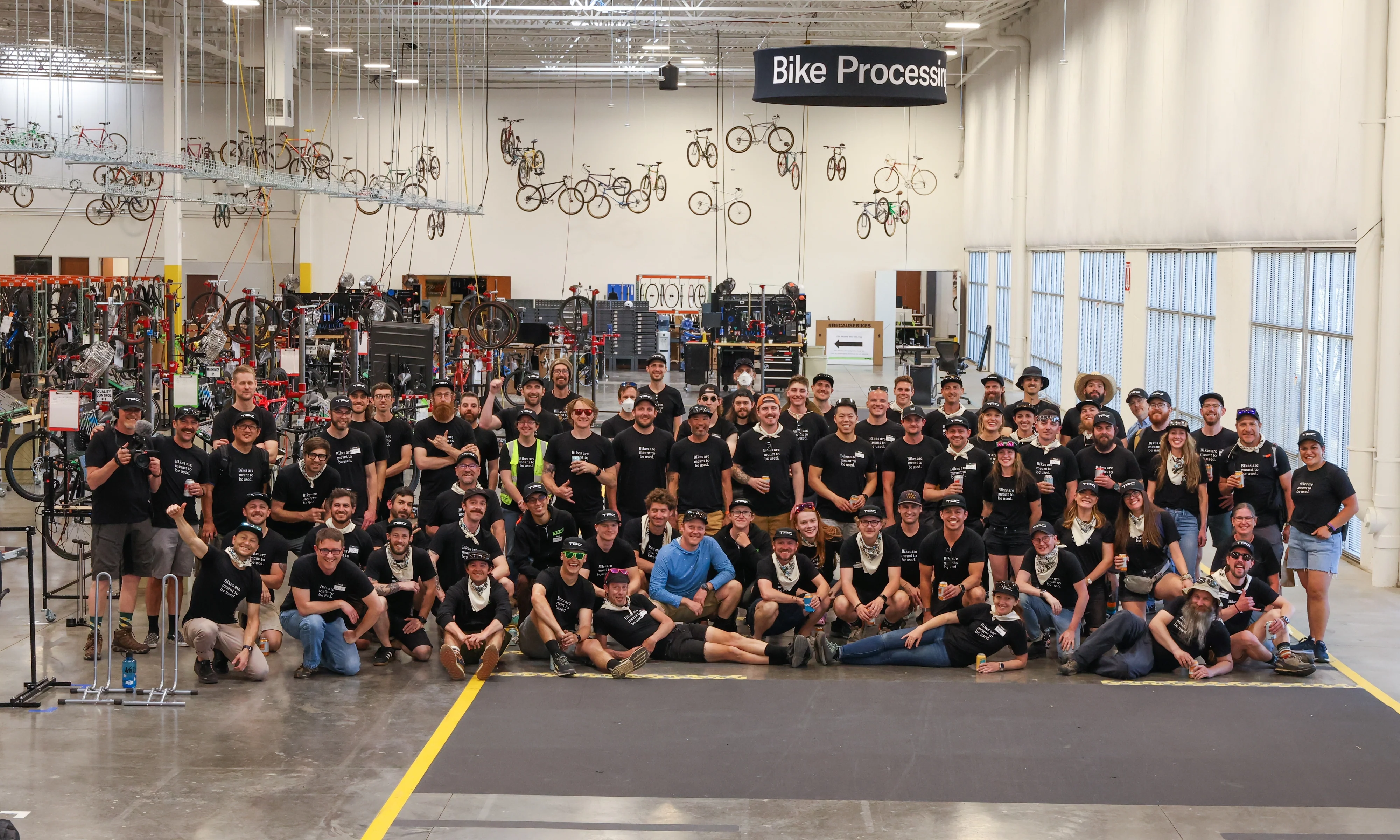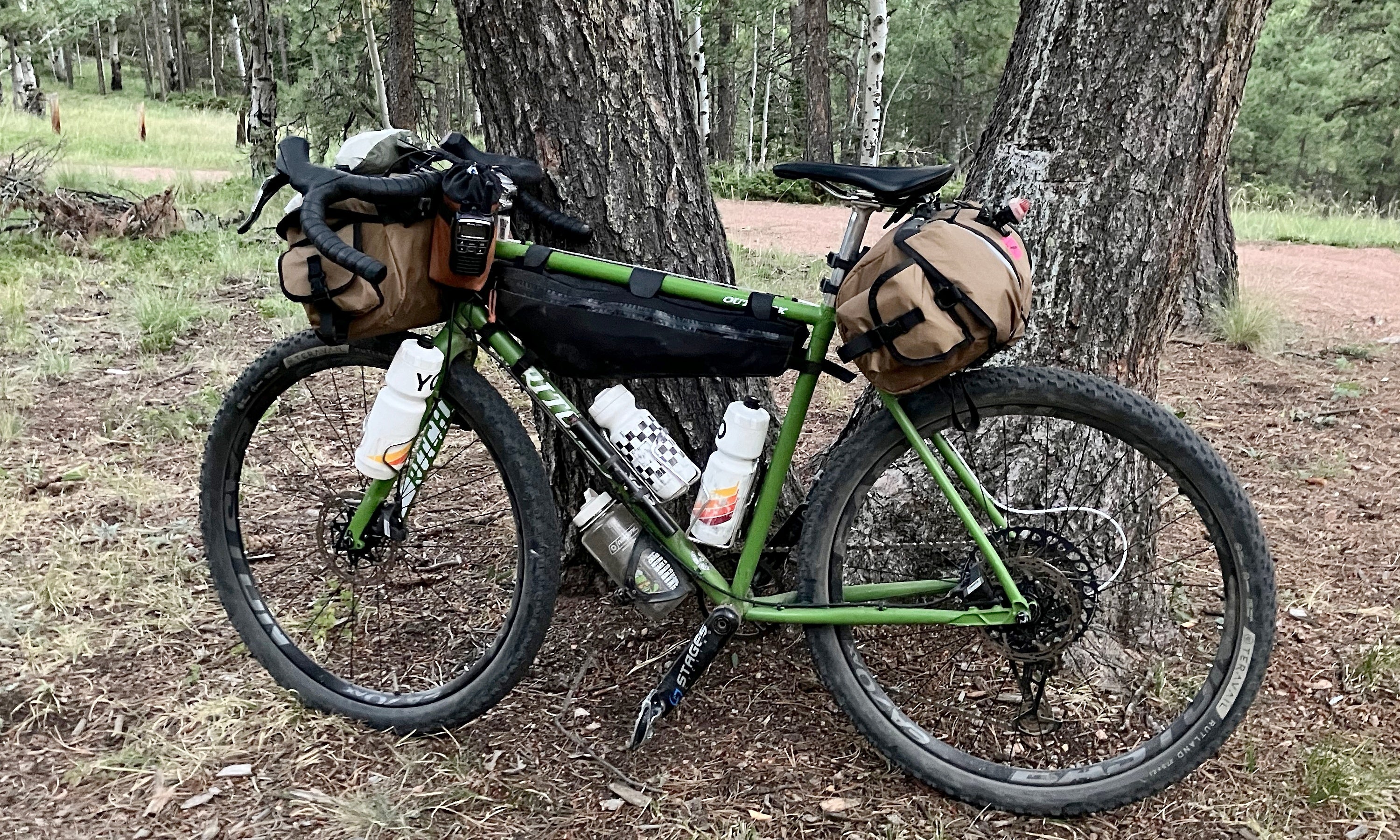Photo: Tyler Phillips
Can you ride gravel on a mountain bike? Yes. Obviously. Anywhere a gravel bike can go, a mountain bike can go just as easily. But what if you want to RACE gravel? Or, at the very least, ride gravel quickly. Are mountain bikes too slow for gravel racing or fast group rides? I had the chance to test it out for myself.
I went to Foco Fondo, my biggest local gravel event, and raced the full 118-mile “Quadruple Dog Dare You” course. Since Foco Fondo is three weeks before my next major target — the Leadville Trail 100 MTB — I decided to race it on my mountain bike. It went about how I expected…
Gravel Bikes vs. Mountain Bikes
|
Gravel Bikes |
XC Mountain Bikes |
|
|
Handlebars |
Drop bars |
Flat/riser bars |
|
Tires |
40mm-50mm wide |
2.0”-2.4” wide |
|
Gearing |
Better for high speeds |
Better for steep climbs |
|
Suspension |
None or very little |
Usually some (100-120mm) |
|
Riding Position |
More aero |
Less aero |
|
Weight |
Lighter (~16-25 lbs) |
Heavier (~22-27 lbs) |
|
Ideal Terrain |
Gravel… duh |
Singletrack trails |
My Mountain Bike Setup

I’m riding a 2021 Specialized Epic EVO, which is considered a “downcountry” XC bike with 115mm of rear suspension and a 120mm fork. I bought it used from TPC and it came to me with knobby trail tires, wide 760mm handlebars, and a short 60mm stem.
To make it a bit more gravel-friendly, I essentially pushed it more toward the XC racing side of the MTB spectrum. The two biggest changes I made were to the tires and cockpit. The bike came with aggressive Specialized Purgatory/Ground Control tires, which I swapped for faster-rolling Vittoria Peyote XC tires. These tires are more low profile, so they’ll be much faster on smooth gravel and pavement than knobby trail tires. They’re lighter too.
The stock cockpit was great for technical trail riding, but for racing, it’s a bit too short and upright. My new setup uses narrower 720mm handlebars paired with a negative rise 100mm stem. This allows me to stretch out and engage my glutes to produce power on flat sections and it makes me a tiny bit more aero. I also wrapped the center of my bars with bar tape to provide extra hand positions. I can grip the center of the bars or place my forearms on the bar (a.k.a. “puppy paws”) to adopt a faux aerobar position.
I didn’t touch my gearing, but if I had a bit more time (and money), I likely would have purchased a bigger 36t chainring to replace the stock 34t chainring. A slightly harder gear makes it easier to hold high speeds on flat and slightly downhill terrain.
During the race, I left my suspension locked out to maximize efficiency. With the larger MTB tires, comfort wasn’t an issue. The only time I unlocked my suspension was on a super rough and rocky descent.
While these changes improve my bike for gravel racing, this is actually the same setup I’ll use for Leadville. Despite being a mountain bike race, Leadville mostly raced on steep, rough, and rocky fire roads and doubletrack. My bike is optimized for this. For smoother gravel and flat or rolling terrain, it’s probably still a bit overkill.
Where the MTB Struggled

Getting dropped 😭.
I got BLOWN UP in this race. Compared to my gravel bike, I struggled to hold wheels on flat and smooth roads, especially when speeds increased. Of course, a lot of this is a fitness issue, but there were a few aspects of my setup that I found lacking:
Gearing - This was probably the biggest issue. With a 34x10t top gear, I was capable of exceeding 20mph, but holding these sorts of speeds required spinning faster than I was comfortable (>110 RPM). My Strava said I hit 140 RPM several times! Spinning this fast is fine to do occasionally, but I had to do it so often and for so long that it burnt a lot of matches. A bigger chainring would have certainly helped.
Riding position - With flat handlebars, I struggled to get as low as I wanted. In fast gravel races, I ride in the drops A LOT. This not only makes you more aero, but it also helps engage your glutes, which are your biggest and most powerful muscles. With the more upright riding position, I found it hard to produce steady power for extended periods. That said, if I trained in this riding position more regularly, I’m sure I’d improve. Right now, I’m more accustomed to the lower riding position of my gravel bike, and the mountain bike felt quite alien.
Tires - Despite using low-profile and fast-rolling XC tires, I can’t help but think that using tires that are 2.4” wide (with inserts too!) is simply overkill for smoother gravel and pavement. If I could buy mountain bike tires specifically for gravel racing, I’d prefer something in the 2.0-2.2” range.
Frame stiffness - Even with my rear suspension locked out, my mountain bike doesn’t feel as stiff or efficient as my gravel bike when I jam on the pedals. It doesn’t seem to respond to attacks, jump out of corners, or accelerate as quickly. I am riding a full-suspension bike, so a lot is going on back there with the shock, pivots, and linkages. A hardtail would feel a lot better on gravel.
Weight - Eh, yeah… my mountain bike is over 7 pounds heavier than my gravel bike. I’m often the first to say that bike weight doesn’t matter, but when I’m hunting for excuses, this is an easy one to pick on. On the flats, weight really shouldn’t matter, but my heavier mountain bike just doesn’t feel as spry or lively as my gravel bike.
My legs - Ultimately, the motor matters more than the bike. A fitter or stronger rider would have a much easier time hanging with gravel bikes, but it still doesn’t mean it’s the right tool for the job.
Where the MTB Shined

- Rough Terrain
- Loose Corners
- Super Steep Climbs
- Overall Comfort
The mountain bike excelled whenever the terrain got rough. Foco Fondo has a long doubletrack trail section and a very rocky descent after the main climb. With big tires, flat bars, suspension, and a dropper seatpost, I flew through these sections. They weren’t long enough for me to consider the mountain bike ideal for the entire course, but when I hit them, I was very happy. Likewise, loose corners are so much easier to navigate with wide tires and flat handlebars. You can rally through them with so much confidence.
On super steep climbs, the extra-low mountain bike gearing was super nice. With a 34x52t granny gear, I never had to get off and walk, and I was able to easily spin up the most brutal climbs. On tough climbs, the gearing easily makes up for any additional weight or lack of climbing fitness.
Finally, the comfort was exceptional. This might be the most pampered my backside and hands have ever felt after a 7+ hour gravel race. The wide 2." tires and low tire pressures were the main contributors to my comfort (especially since I kept the suspension locked out most of the time). With all that plushness, bumps just didn’t bother me.
Final Thoughts
Riding my Leadville bike in a gravel race was a fun experiment. I’m still going to reach for my gravel bike when it’s time to take a race seriously, but I do feel like there are a couple of key learnings to take away from this experience:
- If you don’t care about race results and want to maximize your comfort, confidence, and gears for climbing a mountain bike is a great choice.
- If you want more comfort and confidence on your current bike, using the widest tires possible will make the biggest difference.

It looks horrifying, but Lachlan Morton's 2023 Leadville bike would probably rip gravel. Photo: Betsy Welch
What if, hypothetically, I wanted to build a mountain bike optimized for gravel racing? What would I do? Here’s my dream crossover rig:
- A lightweight carbon hardtail frame
- Rigid carbon seatpost
- Fox 32 Step-Cast fork (one of the lightest XC forks on the market)
- Super lightweight carbon wheels (e.g. Roval Control SL)
- Narrower/faster tires (e.g. 2.2” Continental Race Kings, 2.25” Schwalbe Thunder Burts)
- A 36-40t chainring
- A very aggressive cockpit (long negative rise stem, narrow bars)
This mountain bike would suck to ride on a lot of my local trails, but on gravel, it would have a pretty good chance of hanging with fast gravel bikes. Maybe I’ll have a fun project in the future!

























